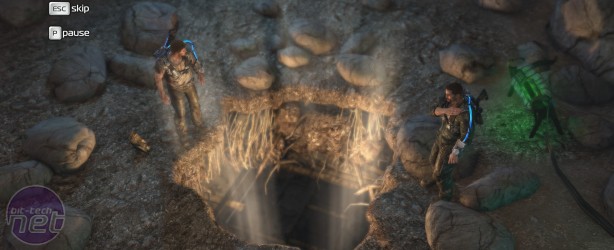
Inversion Review
Supposedly though, there's one feature in Inversion that should stand out and at least partly redeem Saber's efforts - the grav-link system, which is presented as a weapon and effect used by the Lutadore in their invasion.While the idea of gravity control is interesting as a gimmick however, the presentations which Inversion makes use of are all too flawed to ever make the system feel worth exploring in any depth.
The main use of the grav-link, for example, is as a weapon which either floats or sinks your target relative to its surroundings. Float a clutter of debris, for example, and you'll be able to grab boulders to launch at your enemy - though you could also just float the enemy out of cover and shoot them yourself. It ends up being the grav-link's alternate mode that's more useful: make floating crates heavier and they'll drop to ground as extra cover.
Why are there floating crates, I hear you ask?
Well, the other main presentation of the gravity system is in localised fields; areas where the rules of gravity do not apply or have been temporarily altered to fit different rules. There are sections where chunks of scenery float in the air, for example, and you have to launch yourself from one to another using, or where you're force to fight across ceilings and walls.
What unites all these presentations more than the occasional sense of vertigo however is that none of them really do all that much to change the moment-to-moment action you're involved in. Fighting across the ceilings and walls is all well and good, for example, but as your viewpoint shifts to accommodate the new perspective all it really means is that you're fighting across a slightly different floor. It doesn't change anything; it's literally as exciting as tilting your head 90 degrees left or right.
The weaponised grav-link, meanwhile, is basically just a bit too cumbersome to be useful outside of some specific instances. It's far easier to shoot enemies with your gun than it is to grab parts of the scenery and lob them around, especially given the third person perspective and lack of trajectory guidance.
Things get worse as Inversion drags on too, with enemies appearing who require specific gravity tactics to defeats but who rarely feel like anything more than hoops to jump through. This ends up doubly true for the bosses, who are insipid enough to begin with before Inversion decides to start recycling them towards the end of the game. It's the sort of tired tactic most other games left behind years ago.
The only really redeeming feature which Inversion possesses is the online co-op option, but given that co-op improves pretty much any game that's not really saying all that much. Still, the multiplayer portion is by far the strongest part of the game, both because fighting with friends is always fun and also because the competitive multiplayer is where the gravity system is explored more thoroughly. Divorced of the constant interruptions of narrative and freed to be a little more nonsensical Saber has modes where levels re-orient based on your progress.
To even suggest that any of these lesser failings make Inversion worth either your time or money is to grossly overstate their worth. Multiplayer may be the best bit of the game, but it's the best bit of a bad game.
-
Overall30 / 100


MSI MPG Velox 100R Chassis Review
October 14 2021 | 15:04











Want to comment? Please log in.